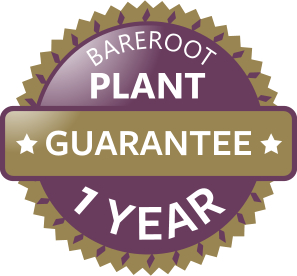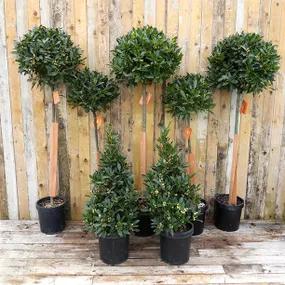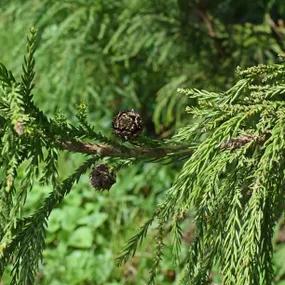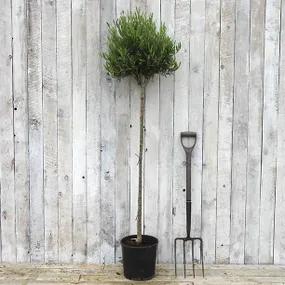Buying Evergreen Trees Online:
Order Potted Evergreen Trees Now For July Delivery
Pre-Order Bareroot Evergreen Trees For 2025/26 Winter Season
Many conifers and evergreens do not transplant well in larger sizes, and get very expensive when they do, so we deliver most evergreen trees as smaller saplings, unlike our much larger standard trees, which are mostly deciduous.
Our largest delivery sizes are rootballed Yew, and Leylandii is the fastest growing.
Browse evergreen hedging plants, which includes smaller shrubs that don't qualify as trees, or all our ornamental trees.
- Order now, pay later: we don't charge your card until before delivery
- When your order is ready: your mail order trees are delivered by next working day courier (not the next working day after ordering!)
- Friendly support: if there is anything wrong with your plants when you inspect them, Contact Us within 5 working days
All bareroot plants are covered by our Refund Guarantee, so you can give them a whirl with complete confidence.
When and How do I Plant Evergreen Trees?
You can plant Pot Grown Evergreen trees at any time of year, and Bareroot Evergreen trees during winter, except when the soil is frozen.
The best time to plant trees is from late Autumn to early Spring (November to March), using bareroot stock, which is cheaper, easier to carry and plant, and tends to establish even better than their pot grown equivalents.
Although optional, we strongly recommend using Rootgrow.
Aftercare:
Remember: the two biggest killers of recently transplanted trees are underwatering, and being choked by weeds and grass.
- Regular, thorough watering is vital during dry weather in their first spring and summer, and highly recommended the following summer, especially if there is a heat wave.
- Either remove weeds and grass by hand periodically, or use some form of mulch to suppress them.
Tree Planting Accessories
A mulch mat is will suppress weeds & grass, and preserve moisture: remember that dry soil and competition with weeds are the two biggest killers of new trees.
Even with a mat, you should remove anything that manages to grow up between the mat and the trunk in late spring and summer.
You definitely need a tree shelter if there are deer or rabbits about, which needs a support stake.
Mycorrhizal Fungi
We cannot recommend using Rootgrow fungi enough: it makes a huge difference, especially with larger trees, which are scrambling to regrow the root systems that they lost when we dug them up, in order to support their now top-heavy growth above ground.
Mycorrhizal fungi assist the roots in accessing soil nutrients and water, and protect the roots from soil critters.
In return, the tree shares sugar with them, and the result can be over 50% more growth above ground!
Which are the Fastest Growing Evergreen Trees?
The fastest growing evergreen trees are:
- Leylandii
- Eucalyptus
- Italian Cypress
And special mention goes to Bamboo, which isn't a tree but certainly grows like the clappers!
Do I Need Woodchips to Mulch Around My Trees?
You don't need to mulch with woodchips specifically, but they do make some of the best mulch for trees and shrubs.
Woodchips make such excellent mulch because they last for a long time, support fungi and soil life as they decay, don't tend to blow away in the wind, and look nice.
Why is mulch so important for trees?
In the broadest sense, mulch is anything that both protects the soil from the sun, and allows water to pass down through it.
This does two essential things: it stops weeds and grass from growing around your tree, and it helps to prevent the soil from completely drying out in summer.
Dry soil and/or competition with weeds are the two biggest reasons why new trees die or grow poorly, so mulch is very useful!
You could mulch with our biodegradable mulch mats for single trees, or plastic mulch fabric (typically used for country hedges), or pretty much any organic matter .
Organic matter has the added bonus of slowly breaking down to feed soil life (this organic matter plus soil life is known as humus) and thus enrich the soil's fertility.
But you can mulch with so many green waste products from your garden: lawn clippings, autumn leaves, old straw (hay too, but it will have a lot more seeds in it), and if aesthetic appeal is not important, you could use old newspapers, non-glossy cardboard, cotton or wool clothes and sheets, hessian sacks - anything that rots and smothers, pretty much.
Unlike compost, which can be dug into the soil or used for potting, mulch does not need to be well rotted, or rotted at all.
The only major exception is chicken and horse manure, which can be too high in nitrogen (known as 'hot') when it's fresh.




 3.webp)

 1.webp)

 1.webp)

 2.webp)
 Hero Img.webp)
 Hero Img.webp)
 3.webp)
 1.webp)
 1.webp)
 2.webp)

 3.webp)
 1.webp)